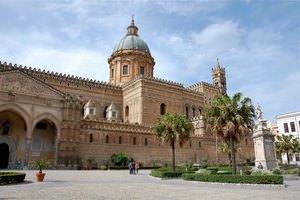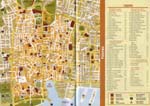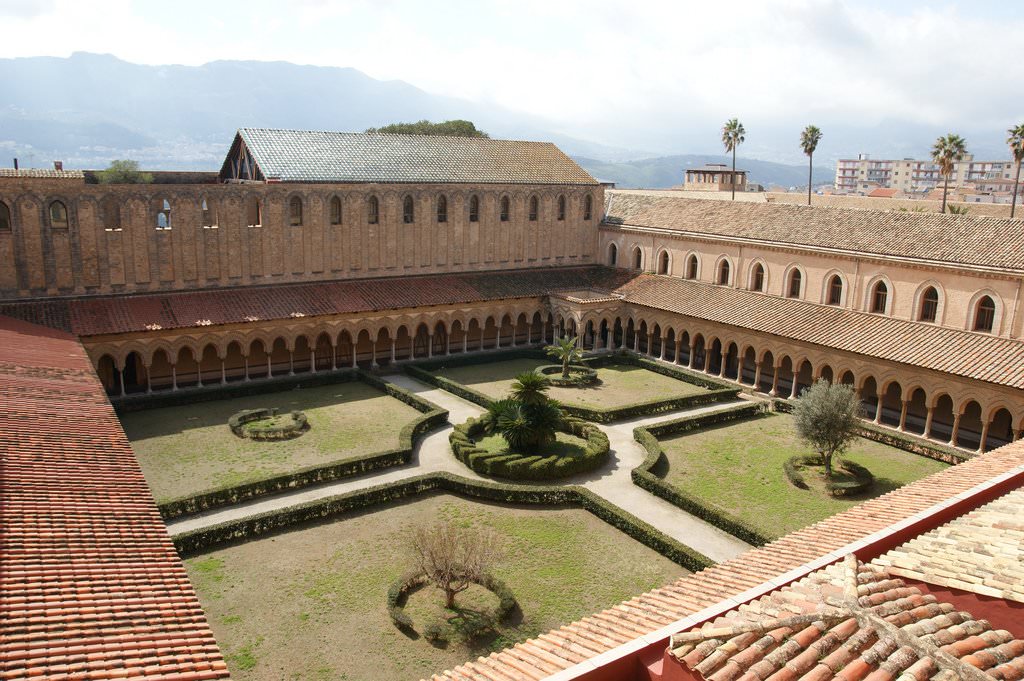Top architectural sightseeing and landmarks of Palermo - ideas on city exploration routes
 The main landmarks, such as Teatro Massimo, Palazzo dei Normanni, Zisa, and Santa Maria della Catena, attract thousands of visitors, who come to Palermo from different parts of the world every year. Palermo is incredibly rich in absolutely stunning landmarks and important historic sights. Stadio Renzo Barbera, Church of the Gesu, are true masterpieces of architecture and architectonics at the international level. It’s time to look at every landmark of Palermo in detail from an unusual point of view – interesting facts with hi-res photos, enriched with a virtual flight over 3D copies of all the architectural monuments.
The main landmarks, such as Teatro Massimo, Palazzo dei Normanni, Zisa, and Santa Maria della Catena, attract thousands of visitors, who come to Palermo from different parts of the world every year. Palermo is incredibly rich in absolutely stunning landmarks and important historic sights. Stadio Renzo Barbera, Church of the Gesu, are true masterpieces of architecture and architectonics at the international level. It’s time to look at every landmark of Palermo in detail from an unusual point of view – interesting facts with hi-res photos, enriched with a virtual flight over 3D copies of all the architectural monuments.
Teatro Massimo, Palermo
Location on the map:  Facts:
Facts:
» The excellent acoustics of the building makes it unique among other cultural institutions in Europe. » Massimo is an opera theater. This was the name of the crowned ruler of Italy.
» In 1874, the city municipality gave permission for the construction of the musical theater. As organizers supposed, it must have been the symbol of the formation of the new European country.
» It was opened in 20 years. The festive event was marked by an opera comedy “Falstaff” of Verdy. The main hero of the performance wants to improve his financial position thanks to married women.
» The total area of the building is 7730 m2. It can accommodate over 3 000 spectators at a time.
» The concert hall has the shape of a horseshoe. The parterre is surrounded by six-tier stands. In the lobby, there are busts of eminent composers. The interior is designed in a classic theatrical style. It is red and golden. Carpets are of the same color.
» Such Italian singers, as Enrico Caruso, Luciano Pavarotti, and Maria Callas, performed on the opera scene.
» The building is associated with mystical stories: sad ghosts appear here because the theater was built at the site of the old graveyard.
Palazzo dei Normanni, Palermo
Location on the map:  Facts:
Facts:
» Palazzo dei Normanni (the Norman Palace) with the Palatine Chapel consists of several rooms. It serves as a museum, liturgies are held here, and there are exhibition rooms. » Throughout its history, the building had been used for different purposes: it was the place where the Sicilian nobles met and where the legislative body sat. In 1947, the Parliament started to meet here.
» The exterior of the mansion is characterized by the mixture of cultures on the island. It is connected with the exploration of Sicily.
» The first shelters belonged to the Phoenicians. Then, Ancient Roman fortifications were constructed here. In the 9th century, Arab conquerors built a palace on the ancient ruins. In the 11th century, the building was “inherited” by Norman regiments invading Italy. Upon the order of the Norman leader, the Mauritanian Palace was rebuilt. It turned into a royal residence. In a few centuries, the residence turned into a Spanish castle. The building was reconstructed again.
» Paintings of modern artists are displayed in its basements.
» The building has a total area of about 400 m.
Zisa, Palermo
Location on the map:  Facts:
Facts:
» The Arabic name “Zisa” (al-Aziza as “shining”) can be literally translated as “beautiful” or “magnificent”. You can still see this title above the entrance. » In the 12th century, King Wilhelm decided to build a house that became his holiday destination when he went hunting. Then, the building was inherited by his descendant. He used the palace as a summer residence. At the beginning of 1800, the house belonged to noble counts. Then, the government of the Sicily Region bought the city residence.
» Nowadays, the northern part of the complex is occupied by the Islamic Art Museum. Here, you can also see interesting artifacts found during excavations on the Mediterranean coast.
» The edges of the roof of Zisa, or the fortress, are notched. There is a marble emblem with lions above the entrance. The main hall is decorated with mosaic panels.
» The main staircase leads to the building. It is divided into two sectors by fountains and a water channel.
» The two-storey construction has two arched doorways. There are relief niches in the main hall that is decorated with mosaics. There had been a fountain at one time but it was dismantled.
» The history of the palace goes back to over 1000 years. It is surrounded by a well-groomed park.
Santa Maria della Catena, Palermo
Location on the map:  Facts:
Facts:
» According to legend, the chains of the prisoners that had been wrongfully sentenced to death evaporated under the rays of sunshine when they turned with a prayer to the Blessed Virgin Mary. » Those who believed in the miracle started to bring offerings. That’s how a house of God was erected here. One of the chain links is bricked up in the wall panel of the church.
» The 14th-century church, where a significant event took place, was named Santa Maria della Catena. Catena means a leash, shackles.
» According to another legend, the Santa Maria building was located near a chain fence. It restricted entry to the port.
» The house of God has an interesting covered balcony under an arch. A luxurious staircase made in the middle of the 19th century leads to it. Inside, there is an unknown painter’s work about sorcerers’ worship of Christ. The bas-relief pictures date from the 16th century.
» One of the chapels is named after Saint Brigid, a Catholic abbess. There’s a canvas (17th century) depicting the majesty of the saint inside the chapel. The ceiling is decorated with religious frescoes.
» The second Christian extension has the 14th-century frescoes inside. One of them features the Blessed Mother Mary. Her baby is portrayed as if as an adult. His bald head symbolizes eternal wisdom.
San Giovanni degli Eremiti, Palermo
Location on the map:  Facts:
Facts:
» The city church was in the care of the Benedictine monks. In 1136, the king ordered Arab workmen to build a refuge for hermits next to his palace. » The abbot of the church in the rank of bishop became the king’s personal confessor. According to the will, the members of the royal family were to find their last shelter here.
» The temple of God fell into disuse for a long time. The restoration work was done only in the late 19th century. The building was turned into a museum.
» The monastery and the adjacent church are considered architectural monuments. They are made in the Arab-Norman style.
» The church is easily recognizable because of its five red arc-shaped domes, which used to be a distinctive feature of the mosques in Egypt and North Africa.
» A four-angled building with narrow windows resembling loopholes adjoins the church. The wall has the remains of frescoes. A local ethnographer assumes there could be a refectory for monks.
» San Giovanni degli Eremiti has an open gallery that makes up a courtyard.
» The interior is austere. There are no mosaics, no frescoes, no wall paintings. Only walls remained intact.
» The church resembles letter T in shape.
Stadio Renzo Barbera, Palermo
Facts: » The history of the oval stadium goes back to 1932.
» The sports ground was reconstructed completely in 1989. At that time, seats for sports fans were retrofit and the covered shed was constructed above the main stand. The new illumination system and huge displays let see everything happening in the field.
» Up to 37 thousand people can watch sports competitions at the arena at a time. The stadium was visited by this number of fans only twice in its history when C1 matches were held.
» World Football Championships were also organized at Barbera. The local football teams train at the home arena.
» The name of the stadiums changed several times. The present name is associated with a dramatic event. The sudden death of Renzo Barbera, the chairman of the football club, shocked many people. The sports authorities of the country decided to name the stadium after him to commemorate the eminent businessman.
» Its official name is Stadio Comunale Renzo Barbera.
» The sports ground is located between the residential complex and the mountain range.
» Its total area is 105х68.
Church of the Gesu, Palermo
Facts: » The official name of the church is Santa Maria di Gesù or Casa Professa.
» The religious Society of Jesus was established in the city in the middle of the 16th century. It was decided to build a church for services.
» Casa Professa means the House of Professes. Professes are the supreme rank of the members of the Society of Jesus.
» The church is located on the hilltop. The legend says that hermits lived here. There were also underground funeral galleries.
» The interior is fully decorated with marble and ceramic paintings depicting Biblical scenes. Moldings and frescoes are multicolored. The Church of the Gesu is distinguished by the combination of colorful tiled plates, on which bright patterns are carved. There are also supporting columns with ornaments.
» Painting specialists have recognized the uniqueness of the interior design.
» The exterior seems to be divided into two parts. There are three entrance doors at the lower level. On their sides, there are statues of saint benefactors and Madonna holding a baby in her hands in the niches. Vertical ledges of the walls are decorated with pictures of Christian martyrs carved in stone.
» Under the altar in the basement (crypt), worshipers left their fellows passing away.
This guide to architectural sightseeing in Palermo is protected by the copyright law. You can re-publish this content with mandatory attribution: direct and active hyperlink to www.orangesmile.com.
City tours, excursions and tickets in Palermo and surroundings
Build your walking routes in Palermo on the landmark map
Hilton builds third luxury hotel in Kyoto
The Hilton Kyoto hotel will be attractive to a wide range of guests. Leisure travelers will appreciate the close proximity to famous attractions such as Heian and Yasaka Temples, the Kyoto Imperial Palace, and the scenic Gion Historical District. In a few minutes, guests can reach the metro stations, the path to the sights of interest will not take much time. Read this
Read this
24.04.2024
The Hilton Kyoto hotel will be attractive to a wide range of guests. Leisure travelers will appreciate the close proximity to famous attractions such as Heian and Yasaka Temples, the Kyoto Imperial Palace, and the scenic Gion Historical District. In a few minutes, guests can reach the metro stations, the path to the sights of interest will not take much time.
24.04.2024


 English
English Russian
Russian Dutch
Dutch German
German Spanish
Spanish French
French Türkçe
Türkçe



















